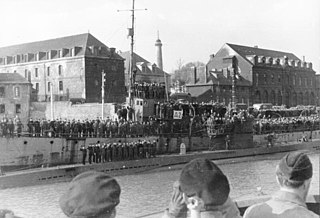
German submarine U-552 was a Type VIIC U-boat built for Nazi Germany's Kriegsmarine for service during World War II. She was laid down on 1 December 1939 at Blohm & Voss in Hamburg as yard number 528, launched on 14 September 1940, and went into service on 4 December 1940. U-552 was nicknamed the Roter Teufel after her mascot of a grinning devil, which was painted on the conning tower. She was one of the more successful of her class, operating for over three years of continual service and sinking or damaging 35 Allied ships with 164,276 GRT and 1,190 tons sunk and 26,910 GRT damaged. She was a member of 21 wolf packs.

USS Grunion (SS-216) was a Gato-class submarine that sank at Kiska, Alaska, during World War II. She was the only ship of the United States Navy to be named for the grunion.

USS Block Island (CVE-21/AVG-21/ACV-21) was a Bogue-class escort carrier for the United States Navy during World War II. She was the first of two escort carriers named after Block Island Sound off Rhode Island and was the only American carrier sunk in the Atlantic during the war.

German submarine U-166 was a Type IXC U-boat of Nazi Germany's Kriegsmarine during World War II. The submarine was laid down on 6 December 1940 at the Seebeckwerft at Wesermünde as yard number 705, launched on 1 November 1941, and commissioned on 23 March 1942 under the command of Oberleutnant zur See Hans-Günther Kuhlmann. After training with the 4th U-boat Flotilla, U-166 was transferred to the 10th U-boat Flotilla for front-line service on 1 June 1942. The U-boat sailed on only two war patrols and sank four ships totalling 7,593 gross register tons (GRT). She was sunk on 30 July 1942 in the Gulf of Mexico.

German submarine U-171 was a Type IXC U-boat of Germany's Kriegsmarine built for service during World War II. It was laid down on 1 December 1940 at the DeSchiMAG AG Weser yard at Bremen as yard number 1011, launched on 22 July 1941, and commissioned on 25 October 1941 under the command of Kapitänleutnant Günther Pfeffer.
The second USS Sapphire (PYc-2) was a patrol boat in the United States Navy.
German submarine U-333 was a Type VIIC U-boat of Nazi Germany's Kriegsmarine during World War II. The submarine was laid down on 11 March 1940 at the Nordseewerke yard at Emden, launched on 14 June 1941, and commissioned on 25 August 1941 under the command of Kapitänleutnant Peter-Erich Cremer. After training with the 5th U-boat Flotilla at Kiel, on 1 January 1942 U-333 was transferred to the 3rd U-boat Flotilla based at La Pallice for front-line service.
German submarine U-566 was a Type VIIC U-boat of Nazi Germany's Kriegsmarine during World War II. The submarine was laid down on 30 March 1940 at the Blohm & Voss yard in Hamburg as yard number 542, launched on 20 February 1941 and commissioned on 17 April under the command of Kapitänleutnant Dietrich Borchert.

German submarine U-509 was a Type IXC U-boat of Nazi Germany's Kriegsmarine during World War II. The submarine was laid down on 1 November 1940 at the Deutsche Werft yard in Hamburg as yard number 305. She was launched on 19 August 1941, and commissioned on 4 November 1941 under the command of Korvettenkapitän Karl-Heinz Wolff.
Blücher was a wolfpack of German U-boats that operated during the World War II Battle of the Atlantic from 14 to 28 August 1942. They attacked the Freetown, Sierra Leone to Liverpool convoys SL-118 and SL-119, and sank six ships for a total of 41,984 gross register tons (GRT), and damaged one (10,552 GRT). The group was named after Gebhard Leberecht von Blücher (1742–1819), a Prussian Generalfeldmarschall in the Napoleonic Wars.

German submarine U-511 was a Type IXC U-boat of Nazi Germany's Kriegsmarine during World War II. The submarine was laid down on 21 February 1941 at the Deutsche Werft yard in Hamburg as yard number 307, launched on 22 September 1941 and commissioned on 8 December 1941 under the command of Kapitänleutnant Friedrich Steinhoff.

German submarine U-66 was a Type IXC U-boat of Nazi Germany's Kriegsmarine during World War II. The submarine was laid down on 20 March 1940 at the AG Weser yard at Bremen, launched on 10 October and commissioned on 2 January 1941 under the command of Kapitänleutnant Richard Zapp as part of the 2nd U-boat Flotilla.

German submarine U-123 was a Type IXB U-boat of Nazi Germany's Kriegsmarine that operated during World War II. After that conflict, she became the French submarine Blaison (Q165) until she was decommissioned on 18 August 1959.

The Battle of the Caribbean refers to a naval campaign waged during World War II that was part of the Battle of the Atlantic, from 1941 to 1945. German U-boats and Italian submarines attempted to disrupt the Allied supply of oil and other material. They sank shipping in the Caribbean Sea and the Gulf of Mexico and attacked coastal targets in the Antilles. Improved Allied anti-submarine warfare eventually drove the Axis submarines out of the Caribbean region.
German submarine U-753 was a Type VIIC U-boat built for Nazi Germany's Kriegsmarine for service during World War II. Commissioned on 18 June 1941, she served with 3rd U-boat Flotilla until 30 November as a training boat, and as a front boat until 13 May 1943 under the command of Fregattenkapitän Alfred Manhardt von Mannstein.

The Bureau of Ocean Energy Management (BOEM) is an agency within the United States Department of the Interior, established in 2010 by Secretarial Order. The oil, gas, and renewable energy related management functions formerly under the purview of the Minerals Management Service (MMS) were delegated to the BOEM and its sister agency, The Bureau of Safety and Environmental Enforcement. Specifically, BOEM is involved in resource evaluation, planning, and leasing.
The Torpedo Alley, or Torpedo Junction, off North Carolina, is one of the graveyards of the Atlantic Ocean, named for the high number of attacks on Allied shipping by German U-boats in World War II. Almost 400 ships were sunk, mostly during the Second Happy Time in 1942, and over 5,000 people were killed, many of whom were civilians and merchant sailors. Torpedo Alley encompassed the area surrounding the Outer Banks, including Cape Lookout and Cape Hatteras.
German submarine U-87 was a Type VIIB U-boat of Nazi Germany's Kriegsmarine during World War II. The submarine was laid down on 18 April 1940 at the Flender Werke (yard) at Lübeck as yard number 283 and launched on 21 June 1941. She was commissioned on 21 June under the command of Kapitänleutnant Joachim Berger. U-87 trained with 6th U-boat Flotilla until 1 December 1941, when she was put on front-line service.

SS Peter Silvester, was an American merchant marine ship built for the United States Maritime Commission. She was operated by the Pacific Far East Line under charter with the Maritime Commission and War Shipping Administration. Peter Silvester was torpedoed and sunk by the German submarine U-862 off the coast of Australia in the Indian Ocean on February 6, 1945. 33 men aboard the ship died and 142 were eventually rescued, with some rescued weeks after the initial sinking.
SS Prunelle was a British cargo ship that the German submarine SM UB-112 torpedoed on 22 August 1918 in the North Sea 2 nautical miles (3.7 km) south east of Blyth, Northumberland. Prunelle was carrying a cargo of jute from London, United Kingdom, to Dundee, Scotland, United Kingdom.











